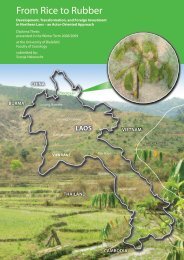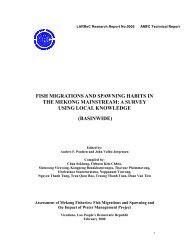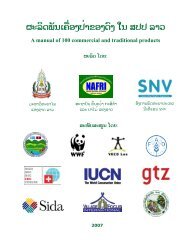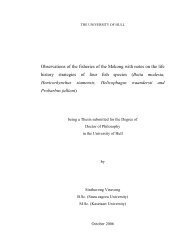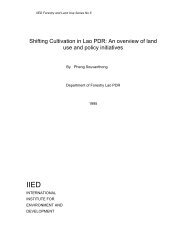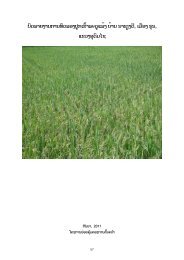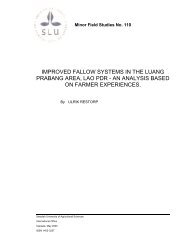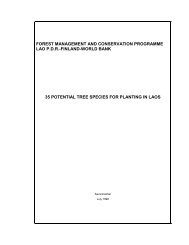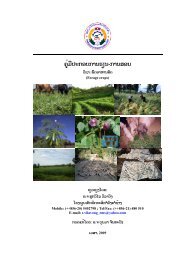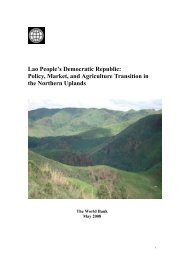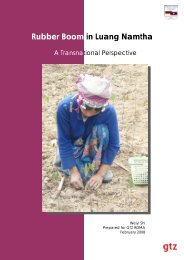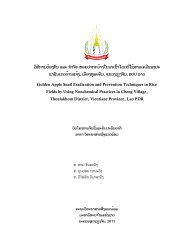The use of Non-Timber Forest Products in Lao PDR. Paper to ... - LAD
The use of Non-Timber Forest Products in Lao PDR. Paper to ... - LAD
The use of Non-Timber Forest Products in Lao PDR. Paper to ... - LAD
You also want an ePaper? Increase the reach of your titles
YUMPU automatically turns print PDFs into web optimized ePapers that Google loves.
“ <strong>The</strong> <strong>use</strong> <strong>of</strong> NTFP’s <strong>in</strong> <strong>Lao</strong> <strong>PDR</strong>” , Foppes, J. & Sounthone. K., NTFP Project (IUCN/DOF)Oud Nak Sal Cha <strong>to</strong>tal men wome by village groups <strong>in</strong> all 28 villagesn1 bambooshoots 14 6 23 9 13 13 17 11 rattan shoots 31 hakt<strong>in</strong>houng2 fish 14 12 14 10 13 7 12 bamboo canes 32 shrimps3 vegetables 12 6 9 11 9 11 11 13 pandan mats 33 chouang bark4 wildlife 11 10 1 12 8 11 6 14 mak khene 34 paper mulberry5 cardamom 13 10 5 7 7 7 15 po piet 35 mak khene6 rattan canes 7 5 4 6 6 6 6 16 saphan 36 sticklack7 kisi res<strong>in</strong> 14 3 4 5 2 4 17 galangal (kha) 37 various shoots8 frogs 19 0 5 5 5 18 malva nuts 38 fuelwood9 mushrooms 4 4 2 7 4 3 6 19 snails 39 kheua kao10 yang oil 8 8 4 4 4 20 bone hom 40 dok lao (fibres)Total <strong>to</strong>p 10 61 67 81 76 71 74 74 21 benzo<strong>in</strong> 41 vomica nutsrest 40products 39 33 19 24 29 26 26 22 tubers 42 othersAll 50 products 100 100 100 100 100 100 100 23 khem grass 43 ya nang24 fruits 44 teakleaves25 makkhamphep 45 sakhan26 grass thatch 46 bong bark27 bia lai 47 honey28 bai kho leaves 48 v<strong>in</strong>es kheua29 eaglewood 49 fibres po30 kheua hem 50 bialai leaves<strong>The</strong> ma<strong>in</strong> other source <strong>of</strong> <strong>in</strong>come besides NTFP’s is <strong>in</strong>come from lives<strong>to</strong>ck sales. Rice sales rank low as asource <strong>of</strong> <strong>in</strong>come. This represents the general low levels <strong>of</strong> rice surpl<strong>use</strong>s and frequent rice shortages thatvillagers have <strong>to</strong> cope with. Income from <strong>of</strong>f-farm activities as shops or labour is very limited.Table 2: Villager’s rank<strong>in</strong>g <strong>of</strong> <strong>in</strong>come sources, 28 villages, 1996.Income source Group Oud Nak Sal Cham TOTALCardamom medic<strong>in</strong>al 21% 10% 0% 6% 9.5%plantFish animal food 0% 12% 2% 13% 7.0%Wildlife animal food 8% 10% 2% 4% 5.8%Damar res<strong>in</strong> exudate 14% 5% 4% 5.6%Bamboo shoots plant food 7% 4% 1% 3.0%Rattan canes fiber 0% 5% 0% 5% 2.6%Saphan exudate 10% 2.5%Bong bark exudate 8% 2.0%Rattan shoots plant food 1% 7% 1.8%Yang oil exudate 4% 4% 1.8%Others 14% 8% 19% 14% 13.6%Total NTFP's 61% 78% 33% 48% 55%Other sourcesLives<strong>to</strong>ck 16% 16% 39% 27% 24%Rice 8% 21% 9% 9%Other crops 14% 3% 3% 12% 8%Labour 1% 3% 1%Off-farm <strong>in</strong>come 1% 2% 4% 1% 2%Total others 39% 22% 67% 52% 45%TOTAL 100% 100% 100% 100% 100%4.3 Ho<strong>use</strong>hold <strong>in</strong>terviews<strong>The</strong> third method we <strong>use</strong>d <strong>to</strong> asses the importance <strong>of</strong> NTFP’s was a short questionnaire survey, focus<strong>in</strong>g onthe family economy. As this was not done <strong>in</strong> all locations, we will present here a data set from the Nakaiarea by way <strong>of</strong> example.6
“ <strong>The</strong> <strong>use</strong> <strong>of</strong> NTFP’s <strong>in</strong> <strong>Lao</strong> <strong>PDR</strong>” , Foppes, J. & Sounthone. K., NTFP Project (IUCN/DOF)Another important po<strong>in</strong>t <strong>to</strong> make is the difference <strong>in</strong> dependency on NTFP’s between poorer and richerfamilies. <strong>The</strong> absolute quantity <strong>of</strong> <strong>in</strong>come derived from NTFP’s is not so much different between poorerand richer families. In fact richer families, who usually have larger number <strong>of</strong> persons at their disposal, tend<strong>to</strong> collect more NTFP’s than poorer families. However the poor families are almost <strong>to</strong>tally dependent onNTFP’s as their sole source <strong>of</strong> <strong>in</strong>come (90%). <strong>The</strong> richest families get only 23% <strong>of</strong> their cash <strong>in</strong>come fromNTFP’s, as they have also <strong>in</strong>come from lives<strong>to</strong>ck sell<strong>in</strong>g and other sources. This is aggravated by the factthat richer families do not have <strong>to</strong> spend this <strong>in</strong>come buy<strong>in</strong>g rice, but poorer families spent everyth<strong>in</strong>g onbuy<strong>in</strong>g rice and then still need <strong>to</strong> borrow more or go hungry. Villagers mention the <strong>use</strong> <strong>of</strong> tubers and otherNTFP’s as a substitute for rice <strong>in</strong> such a situation. We need <strong>to</strong> do more <strong>in</strong>tensive survey work <strong>to</strong> get moredef<strong>in</strong>ite <strong>in</strong>formation on the role <strong>of</strong> NTFP’s emergency food.5 Exports <strong>of</strong> NTFP’s<strong>The</strong> M<strong>in</strong>istry <strong>of</strong> Agriculture produces yearly export statistics <strong>of</strong> NTFP’s exported (see table 5).Table 5: Exports <strong>of</strong> NTFP’s from <strong>Lao</strong> <strong>PDR</strong>, 1995-1996(Sources : Quantities: M<strong>in</strong>. <strong>of</strong> Agriculture; Prices: estimates from our own market research).Quantity Unit Price (kip) Value(kip) Value($)1 cardamom 461,337 kg 4,500 2,076,016,500 2,232,2762 "kisi" damar res<strong>in</strong> 3,098,192 kg 160 495,710,720 533,0223 sugar palm fruits 865,109 kg 500 432,554,500 465,1124 bong bark 1,236,675 kg 130 160,767,750 172,8695 broom-grass 502,266 kg 250 125,566,500 135,0186 orchid stems 49,000 kg 2,000 98,000,000 105,3767 rattans (big diameter) 246,366 stems 372 91,648,152 98,5468 paper mulberry bark 563,402 kg 150 84,510,300 90,8719 dried lizards 7,237 sk<strong>in</strong>s 11,141 80,627,417 86,69610 yang oil 185,240 liter 337 62,425,880 67,12511 eaglewood 3,327 kg 10,000 33,270,000 35,77412 bamboo shoots 165,000 kg 200 33,000,000 35,48413 "hak t<strong>in</strong> hung" ferns 10,160 kg 3,232 32,837,120 35,30914 benzo<strong>in</strong> 15,866 kg 2,000 31,732,000 34,12015 bamboo canes 141,655 stems 200 28,331,000 30,46316 Draceana plants 103,261 kg 245 25,298,945 27,20317 rattan fruits 41,288 kg 500 20,644,000 22,19818 "peuak meuak"/”saphan” 107,500 kg 187 20,125,000 21,64019 malva nuts 17,230 kg 558 9,614,340 10,33820 "si siet" bark 5,000 kg 1,500 7,500,000 8,06521 rattans (small diameter) 37,398 stems 150 5,609,700 6,03222 vomica nuts 23,632 kg 134 3,166,688 3,40523 "kheua hem" 58,900 kg 10 589,000 63324 sticklack 2,200 kg 150 330,000 35525 charcoal 234,500 kg 100 23,450,000 25,21526 <strong>in</strong>cense powder 100 kg ? - -27 "man on l<strong>in</strong>g" 3,355 kg ? - -28 "kheua tip ti" 22,000 kg ? - -TOTAL 3,983,325,512 4,283,146Table 6: Ma<strong>in</strong> exports from <strong>Lao</strong> <strong>PDR</strong> <strong>in</strong> 1996.PRODUCTVALUE(million $)% OF TOTALEXPORTSNTFP’s 4,3 2.5<strong>Timber</strong> 64.5 38Manufactur<strong>in</strong>g (ma<strong>in</strong>ly textiles) 45.0 27Hydropower electricity 16.0 9.5C<strong>of</strong>fee 12.0 7Others 26.5 168
“ <strong>The</strong> <strong>use</strong> <strong>of</strong> NTFP’s <strong>in</strong> <strong>Lao</strong> <strong>PDR</strong>” , Foppes, J. & Sounthone. K., NTFP Project (IUCN/DOF)TOTAL 168.3 100In general, exports <strong>of</strong> NTFP’s from Champasak Prov<strong>in</strong>ce rose sharply <strong>in</strong> volume between 1994 and 1996(see Annex 2). E.g exports <strong>of</strong> yang oil <strong>in</strong>creased from 83 <strong>to</strong>nnes <strong>in</strong> 1994 <strong>to</strong> almost 700 <strong>to</strong>nnes <strong>in</strong> 1996.While yang oil’s price rema<strong>in</strong>ed stable around $0.35, the price <strong>of</strong> cardamom went up sharply from $1-$4 <strong>in</strong>the same period. This trend <strong>in</strong>dicates that pressure on forest resources by outside buyers is <strong>in</strong>creas<strong>in</strong>g. Itunderl<strong>in</strong>es the need <strong>to</strong> develop susta<strong>in</strong>able management systems <strong>to</strong> avoid depletion <strong>of</strong> the resource base.Another issue with the export <strong>of</strong> these products is the large price <strong>in</strong>crease accrued along the market<strong>in</strong>gcha<strong>in</strong>. An example <strong>of</strong> this can be seen <strong>in</strong> the trade <strong>of</strong> yang oil (also known as gurjun oil), the oleors<strong>in</strong> <strong>of</strong>Diprterocarpus alatus. <strong>The</strong> villagers <strong>in</strong> <strong>Lao</strong>s sell their product for US$0.16/kg and the f<strong>in</strong>al Bangkok buy<strong>in</strong>gprice is at least US$1.20/kg. (see table 7). <strong>The</strong> distribution <strong>of</strong> pr<strong>of</strong>its along the market channel shown <strong>in</strong> thetable above <strong>in</strong>dicates that the greatest jump <strong>in</strong> prices occur between the village collec<strong>to</strong>r and the exporter <strong>to</strong>Thailand and <strong>to</strong> a lesser degree between the exporter and the f<strong>in</strong>al Bangkok price.Table 7: Prices <strong>of</strong> yang oil from <strong>Lao</strong> forest collec<strong>to</strong>r <strong>to</strong> Bangkok.level:villagecollec<strong>to</strong>rvillagebuyerdistricttraderexporter <strong>to</strong>Thailandexporter fromBangkoksale price: US$ 0.16 US$ 0.26 US$ 0.48 US$ 0.70 US$1.20It therefore seems that a <strong>use</strong>ful <strong>in</strong>tervention would be <strong>to</strong> assist the collec<strong>to</strong>rs <strong>to</strong> form an association whichsells directly <strong>to</strong> the Thai importer. In the case <strong>of</strong> yang oil this might be an <strong>in</strong>termediary or a representative<strong>of</strong> a company based <strong>in</strong> Bangkok which is distributed directly <strong>to</strong> cus<strong>to</strong>mer. Support<strong>in</strong>g the market cha<strong>in</strong> atthis l<strong>in</strong>k would also help solve some <strong>of</strong> constra<strong>in</strong>ts mentioned by Thai importers referred: difficulties <strong>in</strong>deal<strong>in</strong>g with <strong>Lao</strong> entrepreneurs, delivery problems, quality problems and so on.Yang oil also provides a good example <strong>of</strong> the problem <strong>of</strong> lack <strong>of</strong> clear government regulations. S<strong>in</strong>ce 1995,the Prov<strong>in</strong>cial authorities <strong>of</strong> Champasak prov<strong>in</strong>ce did not issue new quota for yang oil exports from itsProv<strong>in</strong>ce, say<strong>in</strong>g that yang oil harvest<strong>in</strong>g <strong>of</strong>ten ca<strong>use</strong>s forest fires and <strong>in</strong>creased the death <strong>of</strong> yang trees.This action potentially reduces <strong>in</strong>come earn<strong>in</strong>g possibilities for villagers. Accord<strong>in</strong>g <strong>to</strong> the villagers, as<strong>in</strong>gle tree can be tapped for 50 years if handled well. It would seem that this is a durable system, providednew trees are planted. This issue should be <strong>in</strong>vestigated further. <strong>The</strong> project could provide objectivemethods <strong>of</strong> moni<strong>to</strong>r<strong>in</strong>g <strong>of</strong> the production and biodiversity <strong>in</strong>dica<strong>to</strong>rs, that could be <strong>use</strong>d as basis for mak<strong>in</strong>gpolicy decisions.F<strong>in</strong>ally, there is the problem <strong>of</strong> unrecorded trade, which is not taken <strong>in</strong><strong>to</strong> account <strong>in</strong> <strong>of</strong>ficial figures. A goodexample is the lively trade <strong>in</strong> orchids and other ornamentals, tak<strong>in</strong>g place at the <strong>Lao</strong>-Thai border. Oursurvey identified some 90 species <strong>of</strong> ornamentals be<strong>in</strong>g exported, <strong>of</strong> which 56 species <strong>of</strong> wild orchids. Onaverage 5,000- 7,000 plants are sold per month. This trade leads <strong>to</strong> rapid ext<strong>in</strong>ction <strong>of</strong> rare orchid species.<strong>The</strong> average price at the <strong>Lao</strong> side is 12 baht ($0.50) per plant, at the Thai side it is 38 baht ($1.50) per plant.Most plants are directly transported <strong>to</strong> Bangkok, where they fetch prices from anyth<strong>in</strong>g between twodollars <strong>to</strong> five thousand dollars per plant. <strong>The</strong> size <strong>of</strong> this trade is estimated at $100.000 per year, mak<strong>in</strong>gorchids the fifth biggest exported forest product <strong>of</strong> Champasak prov<strong>in</strong>ce after timber ($10.9 million) , malvanuts ($900,000), cardamom ($500,000) and yang oil ($100,000). Three ma<strong>in</strong> options could be explored bythe project: (i) feasibility study for cultivation <strong>of</strong> orchids <strong>in</strong> villages; (ii) group build<strong>in</strong>g among marketsellers, <strong>to</strong> get more control on the trade; (iii) trade bans on endangered species.6 Traditional <strong>use</strong> areas and boundaries6.1 Participa<strong>to</strong>ry mapp<strong>in</strong>g <strong>of</strong> forest resourcesWhere do villagers collect their NTFP’s from? We <strong>use</strong>d three data collection methods <strong>to</strong> answer thisquestion: land-<strong>use</strong> type rank<strong>in</strong>g, forest block rank<strong>in</strong>g and sketch mapp<strong>in</strong>g. In addition, we did rapid forest<strong>in</strong>ven<strong>to</strong>ries <strong>in</strong> each village. In general villagers discern ma<strong>in</strong> land <strong>use</strong> types such as dry dipterocarp andevergreen forests, paddy fields and upland rice/fallow fields , streams and ponds etc. With<strong>in</strong> the evergreenforest, they discern many forest blocks, usually del<strong>in</strong>eated by streams “huay” or other landscape featuressuch as roads or rocks. Aga<strong>in</strong> we will <strong>use</strong> a data set from the Nakai area <strong>to</strong> illustrate our results.Firstly we asked villagers <strong>to</strong> def<strong>in</strong>e and rank ma<strong>in</strong> land-<strong>use</strong> types where NTFP’s are collected. (see table 8).Interest<strong>in</strong>gly, an overall 60 % <strong>of</strong> NTFP’s was classified as collected from streams, ponds, paddy fields,grass fields, and fallow fields which are not strictly forest areas. Only 25 % was said <strong>to</strong> be derived for theevergreen forest and mounta<strong>in</strong>s.9
“ <strong>The</strong> <strong>use</strong> <strong>of</strong> NTFP’s <strong>in</strong> <strong>Lao</strong> <strong>PDR</strong>” , Foppes, J. & Sounthone. K., NTFP Project (IUCN/DOF)Table 8: Collection areas for NTFP’s, ranked accord<strong>in</strong>g <strong>to</strong> relative importance, byvillagers <strong>in</strong> 3 villages on the Nakai Plateau, March 1997.Village Nakai Sopphene Thalang AllLandtype men/women men women men women men women men women overalldong/pou evergreen forest/mounta<strong>in</strong>s 15% 29% 25% 25% 32% 22% 24% 25% 25%kok dry dipterocarp/p<strong>in</strong>e forests 25% 13% 14% 20% 8% 16% 15% 16% 16%palao fallow regrowth 20% 26% 14% 15% 8% 18% 14% 20% 17%houay/nong streams/ponds 25% 22% 38% 30% 33% 33% 32% 28% 30%thong/naa grassfields/paddy fields 15% 10% 10% 10% 20% 12% 15% 11% 13%100% 100% 100% 100% 100% 100% 100% 100% 100%Secondly, we would ask villagers <strong>to</strong> specifically list and rank the evergreen forest areas as <strong>to</strong> theirimportance for collect<strong>in</strong>g NTFP’s. Villagers are able <strong>to</strong> identify forest blocks and ma<strong>in</strong> products collectedper block. <strong>The</strong>y also gave estimates <strong>of</strong> the <strong>to</strong>tal yield <strong>of</strong> ma<strong>in</strong> products for each blocks. In the <strong>in</strong>dividualfamily <strong>in</strong>terviews we had also asked the specific quantities collected by each family for each location,which could also be <strong>use</strong>d <strong>to</strong> calculate block yields (see table 9).Table 9: Comparison <strong>of</strong> estimates <strong>of</strong> <strong>to</strong>tal village harvests <strong>of</strong> 3 key NTFP’s <strong>in</strong> 5 villages on theNakai plateau, us<strong>in</strong>g family survey data and villagers forest block rank<strong>in</strong>g estimates.Survey men's block women's blockrank<strong>in</strong>g rank<strong>in</strong>gKhone Ken kisi 4,213 3,950cardamom 711 3,500bong 11,202 10,800Kaoy kisi 17,086 8,300 14,500cardamom 167 280 586bong 1,139 2,000 1,700Nakai kisi 11,878 4,100 47,000cardamom 0 600 75bong 15,414 4,400 2,650Sop Phene kisi 0 61,000 57,000cardamom 0 1,400 55bong 19,030 17,000 2,000Thalang kisi 3,667 29,000 49,500cardamom 0 400 101bong 2,360 18,000 12,700TOTAL kisi 36,844 106,350 168,0005 villages cardamom 879 6,180 817bong 49,145 52,200 19,050For “kisi” res<strong>in</strong>, the family <strong>in</strong>terview estimates were much lower than the block rank<strong>in</strong>g. For cardamom, thewomen’s rank<strong>in</strong>g estimate was close <strong>to</strong> the <strong>in</strong>terview estimate, for bong bark, the men’s estimate was veryclose. Unfortunately, there was no opportunity <strong>to</strong> feed back these differences <strong>to</strong> the villagers <strong>in</strong>volved.Quantitative rank<strong>in</strong>g <strong>of</strong> forest block productivity would seem potentially a powerful and quick <strong>to</strong>ol, but mayneeds more test<strong>in</strong>g.Thirdly, villagers could usually draw a map <strong>of</strong> their resource <strong>use</strong> areas or forest (see map <strong>in</strong> annex 3).<strong>The</strong>se area’s can more or less be matched with the <strong>to</strong>pographical maps. More <strong>in</strong>tensive mapp<strong>in</strong>g could bedone us<strong>in</strong>g <strong>in</strong>expensive GPS units. Such a map could then be <strong>use</strong>d <strong>to</strong> measure densities <strong>of</strong> NTFP’s and<strong>in</strong>terviews with collec<strong>to</strong>rs <strong>to</strong> assess their estimates <strong>of</strong> yield from each block. <strong>The</strong>se villager def<strong>in</strong>ed forestblocks could also become a powerful <strong>to</strong>ol <strong>in</strong> sett<strong>in</strong>g up a truly participa<strong>to</strong>ry system for land <strong>use</strong> plann<strong>in</strong>gand community forest management.7 Ma<strong>in</strong> issues <strong>of</strong> susta<strong>in</strong>ability7.1 Subsistence <strong>use</strong>In the subsistence <strong>use</strong>, depletion <strong>of</strong> wildlife is the most disturb<strong>in</strong>g trend for conservationists. For the localpeople, <strong>in</strong>secure access rights <strong>to</strong> the forest resource and decreased availability <strong>of</strong> products are the ma<strong>in</strong>10
“ <strong>The</strong> <strong>use</strong> <strong>of</strong> NTFP’s <strong>in</strong> <strong>Lao</strong> <strong>PDR</strong>” , Foppes, J. & Sounthone. K., NTFP Project (IUCN/DOF)concerns. <strong>The</strong>se trends need further <strong>in</strong>vestigation. In the follow<strong>in</strong>g paragraphs we outl<strong>in</strong>e some potentialfor solv<strong>in</strong>g these problems.7.1.1 Secur<strong>in</strong>g access rightsAccess rights <strong>of</strong> village communities <strong>to</strong> forest resources may be secured by government allocation <strong>of</strong> land<strong>use</strong> rights <strong>to</strong> these communities. This option has already been frequently proposed by village communitiesand will be untertaken by the project. While a general process <strong>of</strong> land allocation has already been <strong>in</strong>itiatedby the <strong>Lao</strong> Government, the project would have role <strong>in</strong> add<strong>in</strong>g a dimension <strong>of</strong> susta<strong>in</strong>able management.7.1.2 Susta<strong>in</strong>able <strong>use</strong> <strong>of</strong> food products and wildlife<strong>The</strong> <strong>use</strong> <strong>of</strong> food products could be made more susta<strong>in</strong>able by :1- mak<strong>in</strong>g villagers aware <strong>of</strong> the relation between diet and health; try<strong>in</strong>g <strong>to</strong> eat more healthy diets,especially for children;2- explor<strong>in</strong>g the possibility <strong>of</strong> commercialis<strong>in</strong>g some products that are becom<strong>in</strong>g scarce <strong>in</strong> neighbour<strong>in</strong>gThailand, where there is an <strong>in</strong>creas<strong>in</strong>g demand for ‘forest delicacies’ such as ‘man tien’ tubers (Dioscoreasp.) and fruits <strong>of</strong> ‘mak fai’ (Baccaurea sapida);3- mak<strong>in</strong>g sure that there are enough plants and animals left <strong>to</strong> regrow for next year. This will be verydifficult beca<strong>use</strong> the number <strong>of</strong> people is grow<strong>in</strong>g so quickly and the demand for forest products gets biggerevery year, whereas the forest area gets smaller every year. So we also need <strong>to</strong> look at :5- explor<strong>in</strong>g the possibility <strong>of</strong> rais<strong>in</strong>g some quick grow<strong>in</strong>g animals like frogs, fish;6- explor<strong>in</strong>g the possibility <strong>of</strong> plant<strong>in</strong>g some plants which have become scarce;7- hunt<strong>in</strong>g regulations, forest management.7.1.3 Susta<strong>in</strong>able <strong>use</strong> <strong>of</strong> non-food subsistence productsBamboo ho<strong>use</strong>s are found <strong>in</strong> all villages. <strong>The</strong>y are <strong>in</strong>habited by the poorer families. <strong>The</strong> ma<strong>in</strong> reason whypeople try <strong>to</strong> replace bamboo structures with wooden ones is that bamboo is not durable: bamboo mats have<strong>to</strong> be replaced every 3-5 years beca<strong>use</strong> <strong>of</strong> <strong>in</strong>sect damage and rott<strong>in</strong>g. <strong>The</strong>re could be a big potential for<strong>in</strong>troduc<strong>in</strong>g durability treatments <strong>to</strong> prolong the lifetime <strong>of</strong> bamboo products. E.g. the production <strong>of</strong> prepressedbamboo wallmats, presently imported from Vietnam, might f<strong>in</strong>d an easy market <strong>in</strong> <strong>Lao</strong> <strong>PDR</strong>. Asbamboo shoots are also an important consumer product, the production <strong>of</strong> high quality bamboo constructionmaterials may be comb<strong>in</strong>ed with bamboo shoots production.Rattans were collected heavily for export over the past fifteen years. <strong>The</strong>y have become scarce <strong>to</strong> the po<strong>in</strong>tthat commercial exploitation has almost ceased and large diameter rattans are basically depleted. In view <strong>of</strong>the strong world market demand for rattan furniture, it may be worth while <strong>to</strong> try <strong>to</strong> plant rattans, especiallylarge diameter types. This has been done successfully <strong>in</strong> Indonesia and Malaysia. It takes 7-10 years forthese rattans <strong>to</strong> reach harvestable sizes.<strong>The</strong> bark <strong>of</strong> the paper mulberry, ‘po-sa’, Broussonetia papyrifera, has potential for paper handicraftproducts, sold <strong>to</strong> <strong>to</strong>urists <strong>in</strong> northern Thailand <strong>in</strong> the form <strong>of</strong> umbrella’s, stationary paper etc.In many villages, people rely on a large variety <strong>of</strong> traditional medic<strong>in</strong>es for cur<strong>in</strong>g common illnesses suchas s<strong>to</strong>mach problems, cold , fevers, light wounds, etc. This knowledge needs <strong>to</strong> be preserved . Buy<strong>in</strong>g <strong>of</strong>western medic<strong>in</strong>es is ranked high as a source <strong>of</strong> expenditure <strong>in</strong> most villages. Local medic<strong>in</strong>es may be abetter and cheaper alternative <strong>in</strong> some cases. <strong>The</strong> project could raise villagers awareness <strong>of</strong> the value <strong>of</strong>local medic<strong>in</strong>es. Here we seek co-operation with the prov<strong>in</strong>cial health services, who have specialists onmedic<strong>in</strong>al plants.7.2 Commercial <strong>use</strong><strong>The</strong> importance <strong>of</strong> NTFP’s for export was highlighted earlier (see chapter 5) How susta<strong>in</strong>able is this largescale harvest<strong>in</strong>g <strong>of</strong> forest products ? Ecologically, most at risk are products that are heavily <strong>in</strong> demand,harvested destructively and regrow slowly or not at all. Typical examples <strong>of</strong> such products are: orchids,rattans, Dracaena, eaglewood, hak t<strong>in</strong> hung fern roots (see table 10).Table 10: Ecological susta<strong>in</strong>ability <strong>of</strong> various exported NTFP’sCriteria Typical products Level <strong>of</strong> susta<strong>in</strong>ability1destructive harvest<strong>in</strong>g, very slowregrowth only <strong>in</strong> special forestsurround<strong>in</strong>gOrchids, rattans, Draceana,eaglewood,immediate danger2 destructive harvest<strong>in</strong>g, fastregrowth but requir<strong>in</strong>g specialsurround<strong>in</strong>gs“hak t<strong>in</strong> hung” fern roots, “kheuahem” v<strong>in</strong>es,11under threat
“ <strong>The</strong> <strong>use</strong> <strong>of</strong> NTFP’s <strong>in</strong> <strong>Lao</strong> <strong>PDR</strong>” , Foppes, J. & Sounthone. K., NTFP Project (IUCN/DOF)3destructive harvest<strong>in</strong>g, mediumlong regrowth (4-6 years), littlespecial ecological requirements4 fruits, danger <strong>of</strong> cutt<strong>in</strong>g <strong>to</strong> easeharvest<strong>in</strong>g under high harvest<strong>in</strong>gpressure5 exudates, slow depletion <strong>of</strong>s<strong>to</strong>ck through deforestation6 destructive harvest<strong>in</strong>g, fastregrowth, can grow anywhere7 exudates, fast cycle, lowharvest<strong>in</strong>g pressure8 partly cultivated, no effect <strong>of</strong>harvest<strong>in</strong>g on standall barks <strong>of</strong> “bong” , papermulberry, “saphan” & “sisiet”sugar palm fruits, rattan fruits,malva nuts,“kisi” damar res<strong>in</strong>, yang oil,bamboo canes, bamboo-shoots,“khem” grass/brooms, sticklackbenzo<strong>in</strong>,cardamoms<strong>to</strong>cks are be<strong>in</strong>g depleted butcould be rega<strong>in</strong>ed if activelymanagedoverharvest<strong>in</strong>g is probably tak<strong>in</strong>gplace.without forest protection notsusta<strong>in</strong>able on the long runsusta<strong>in</strong>able if some replant<strong>in</strong>g iseffectuatedsusta<strong>in</strong>able if prices get bettervery susta<strong>in</strong>able if ma<strong>in</strong>ta<strong>in</strong>edMost other issues threaten<strong>in</strong>g the susta<strong>in</strong>able <strong>use</strong> <strong>of</strong> NTFP’s have already been discussed above: the generalstate <strong>of</strong> poverty among rural people, rapid deforestation, market pressure from outsiders, unstable prices,lack <strong>of</strong> clear government regulations, lack <strong>of</strong> process<strong>in</strong>g capacity, lack <strong>of</strong> access <strong>to</strong> <strong>in</strong>formation, uncerta<strong>in</strong>tyon forest access rights giv<strong>in</strong>g little <strong>in</strong>centives for communities <strong>to</strong> manage forests. Village collec<strong>to</strong>rs andother stakeholders <strong>in</strong>volved <strong>in</strong> NTFP <strong>use</strong> should become aware <strong>of</strong> these issues <strong>to</strong> be able <strong>to</strong> make <strong>in</strong>formedchoices <strong>to</strong> forge solutions.Before start<strong>in</strong>g any activity like <strong>in</strong>volv<strong>in</strong>g long term <strong>in</strong>vestment <strong>of</strong> commitment, we will have <strong>to</strong> do afeasibility study: what is the potential market, what would our <strong>in</strong>vestments be, what technical skills andwhat <strong>in</strong>puts will be needed, what is an economical size <strong>of</strong> the enterprise etc. etc. This k<strong>in</strong>d <strong>of</strong> feasibilitystudy should be undertaken only after villages have expressed an <strong>in</strong>terest <strong>in</strong> do<strong>in</strong>g such a pilot project.8 Implication for RRA workAbove we have identified a number <strong>of</strong> possible activities that could be undertaken by the project <strong>to</strong>getherwith villagers <strong>to</strong> improve livelihood <strong>to</strong> improve biodiversity conservation. Aga<strong>in</strong> we should stress that theseare merely ideas <strong>to</strong> be put forward <strong>to</strong> villagers for consideration. <strong>The</strong> villagers themselves will have <strong>to</strong>decide how they want <strong>to</strong> proceed. How can the project assist villagers <strong>in</strong> mak<strong>in</strong>g such decisions?<strong>The</strong> project is presently <strong>in</strong>volved <strong>in</strong> a participa<strong>to</strong>ry plann<strong>in</strong>g process (PRA). This process consists <strong>of</strong> aseries <strong>of</strong> meet<strong>in</strong>gs with specific <strong>in</strong>terest groups with<strong>in</strong> one village community. <strong>The</strong>se meet<strong>in</strong>gs weredivided <strong>in</strong><strong>to</strong> two parts: one part focus<strong>in</strong>g on general village development priorities, the second part focus<strong>in</strong>gon NTFP’s. This makes choices easier for villagers. It also allows the project <strong>to</strong> clarify its limited ability <strong>to</strong>support larger village development projects.In the first session, villagers are asked <strong>to</strong> list the five most important village development priorities.Subsequently, villagers were asked <strong>to</strong> list for each priority goal, what their own contribution could be, whatexternal assistance they would require from the government, from our project and from other projects. This<strong>in</strong>formation was recorded on big poster paper, for everybody <strong>to</strong> see (see table 11). We then <strong>to</strong>ld villagersthat we will <strong>in</strong>vestigate each <strong>of</strong> these projects, establish <strong>to</strong> what extent our project could contribute, andseek <strong>to</strong> contact suitable third party organisations who are specialized <strong>in</strong> the required field. We then made anappo<strong>in</strong>tment <strong>to</strong> come back and talk about these subjects <strong>in</strong> a follow-up meet<strong>in</strong>g after 2-3 weeks.Table 11: Format for village development priorities rank<strong>in</strong>gActivity Rank <strong>of</strong> Villagers Government Our project’s Other projectImportance Input Input Input <strong>to</strong> contact12345Part two is a consultation on specific NTFP related activities, that villagers would like <strong>to</strong> engage <strong>in</strong> with theproject. We first reviewed the list <strong>of</strong> NTFP’s collected <strong>in</strong> the village, as recorded dur<strong>in</strong>g earlier RRA work.We then asked villagers <strong>to</strong> select the NTFP’s they would like <strong>to</strong> discuss <strong>in</strong> terms <strong>of</strong> improvement. For each12
“ <strong>The</strong> <strong>use</strong> <strong>of</strong> NTFP’s <strong>in</strong> <strong>Lao</strong> <strong>PDR</strong>” , Foppes, J. & Sounthone. K., NTFP Project (IUCN/DOF)selected NTFP, a small discussion group was formed, by ask<strong>in</strong>g volunteers <strong>to</strong> choose their favourite <strong>to</strong>pic.In any meet<strong>in</strong>g, 3-9 groups would thus be created, consist<strong>in</strong>g each <strong>of</strong> 2-5 persons.Each group was then asked <strong>to</strong> discuss the ma<strong>in</strong> problems and <strong>to</strong> propose solutions for five ma<strong>in</strong> aspects <strong>of</strong>us<strong>in</strong>g this product: harvest<strong>in</strong>g, plant<strong>in</strong>g, process<strong>in</strong>g, market<strong>in</strong>g and conservation/forest management. Atable format was given <strong>to</strong> record the f<strong>in</strong>d<strong>in</strong>gs <strong>of</strong> each discussion group (see table 12). Each discussion groupwould then spend an hour or more <strong>to</strong> discuss and write up their f<strong>in</strong>d<strong>in</strong>gs.Table 12: Format for small group discussions on each NTFP pilot projectActivity Problems Solutions Start<strong>in</strong>g date Do/Not do1 Plant<strong>in</strong>g2 Harvest<strong>in</strong>g3 Process<strong>in</strong>g4 Market<strong>in</strong>g5 Conservation/<strong>Forest</strong> managementReturn<strong>in</strong>g <strong>to</strong> the general group, each discussion group presents its f<strong>in</strong>d<strong>in</strong>gs, which are recorded on a bigsheet <strong>of</strong> paper. We then asked for each proposed activity whether anybody is <strong>in</strong>terested <strong>to</strong> actuallyundertake this activity. If yes, we asked volunteers <strong>to</strong> put their names forward <strong>to</strong> be recorded as an pilotgroup. Next we recorded for each pilot group when their first activity should take place and wen their nextmeet<strong>in</strong>g should be. This would usually be with<strong>in</strong> 2-3 weeks after the present meet<strong>in</strong>g.At the end <strong>of</strong> each session, a group <strong>of</strong> <strong>in</strong>terested <strong>in</strong>dividuals may decide they want <strong>to</strong> carry on with a certa<strong>in</strong>activity or pilot project. Accord<strong>in</strong>g <strong>to</strong> needs, the NTFP project may put <strong>in</strong> associated <strong>in</strong>puts such as tra<strong>in</strong><strong>in</strong>gfor literacy and basic account<strong>in</strong>g skills, small bus<strong>in</strong>ess development, technical tra<strong>in</strong><strong>in</strong>g, gender awarenessetc. In this way, we may be able <strong>to</strong> <strong>in</strong>duce a village development process which may ultimately lead <strong>to</strong> amore susta<strong>in</strong>able <strong>use</strong> <strong>of</strong> NTFP’s.Typical activities now be<strong>in</strong>g undertake at village-level are: experiments on plant<strong>in</strong>g NTFP’s as a cash crop,susta<strong>in</strong>able harvest<strong>in</strong>g, process<strong>in</strong>g/quality control, market<strong>in</strong>g, land allocation and community based forestmanagement. Research on specific <strong>to</strong>pics (e.g. role <strong>of</strong> NTFP’s <strong>in</strong> nutrition, gender analysis, feasibilitystudies for process<strong>in</strong>g/market<strong>in</strong>g), tra<strong>in</strong><strong>in</strong>g <strong>of</strong> staff/<strong>use</strong>r groups and moni<strong>to</strong>r<strong>in</strong>g and evaluation arecont<strong>in</strong>u<strong>in</strong>g <strong>to</strong> feed <strong>in</strong><strong>to</strong> the on-go<strong>in</strong>g PRA process.13



